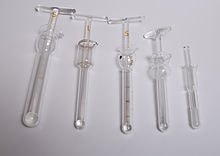Alexander Dounce
Alexander L. Dounce | |
|---|---|
Hamilton College, Cornell University | |
| Known for | Dounce homogenizer; co-discovery of catalase crystallization |
| Spouse | Anna Elizabeth Dounce |
| Scientific career | |
| Fields | Organic chemistry, biochemistry |
| Institutions | Cornell University (1936–1941), University of Rochester (1941–retirement), |
| Thesis | Study of dihydrofurans and the dehydration rearrangement of 2,3-ethylenic 1,4-diols.[1] (1935) |
| Doctoral advisor | James B. Sumner[2] |
| Signature | |
Alexander Latham Dounce (December 7, 1909 – April 24, 1997) was an American professor of biochemistry. Among his fields of study were the isolation and purification of cellular organelles, protein crystallization, enzymes (specifically catalase), DNA binding proteins, and the chemical basis of protein synthesis. He also invented the Dounce homogenizer, which was named after him.
Biography
Alexander Dounce was born on December 7, 1909, in
After his graduation, Dounce stayed in Sumners lab and did work on enzymes, particularly on enzyme isolation and purification. Together with Sumner, he achieved the first crystallization of the enzyme
Also in 1952, Dounce wrote a review article in which he, as one of the first scientists to do so, proposed that
In the same review article, Dounce was also one of the first scientists to propose a genetic code in which nucleotide triplets code for each of the 20 proteinogenic amino acids. He correctly assumed that genes consist of nucleic acid sequences which determine the amino acid sequences of proteins, and that a protein's sequence determines its function. Based on these assumptions, Dounce speculated that, during protein synthesis, each amino acid would pair with an individual nucleotide; the two other nucleotides surrounding it would determine the specificity of the binding. While the actual mechanism turned out to be different, Dounce's hypothesis that nucleotide triplets code for amino acids was correct, and his speculations "helped lead to the deciphering of the code."[5] In the words of Nirenberg, "In the review he was far ahead of everybody else [...]. He predicted that the code would be a triplet code, and that, as I recall, RNA was the template for protein synthesis. But he buried this article in the proceedings of an Oak Ridge symposium that nobody read. [...] By and large, the ideas were good, although he was wrong on minutiae. I was amazed when I finally read it."[2] When

Dounce's work on the isolation of cellular organelles, particularly nuclei and
When Dounce's former mentor, James B. Sumner, died in 1955, Dounce wrote Sumner's obituary in Nature.[13]
For the remainder of his career, Dounce continued his research on nuclei and their contents, catalase, and protein crystallization.
Dounce died on April 24, 1997, in Rochester, New York. He was survived by his wife, Anna Elizabeth Dounce, who was the daughter of botanist Donald Reddick,[14] and by their three children Helen, Eric, and George.[15]
Scientific publications
Key publications
- Dounce, A. L. (September 1935). Study of dihydrofurans and the dehydration rearrangement of 2,3-ethylenic 1,4-diols. ) Dounce's PhD thesis
- PMID 17776781. Description of the first crystallization of catalase
- Kay, E. R. M.; Simmons, N. S.; Dounce, A. L. (1952). "An improved preparation of sodium desoxyribonucleate". . An often-cited method for DNA isolation and purification
- Dounce, A. L. (September 1952). "Duplicating mechanism for peptide chain and nucleic acid synthesis". PMID 13033864. Dounce's speculative review on the mechanism of protein and nucleic acid synthesis
- Dounce, A. L. (1955). "The Isolation and Composition of Cell Nuclei and Nucleoli" (PDF, 35.3 MB). In LCCN 54011055. First detailed description of the Dounce homogenizers
Further publications
Complete list of PubMed-listed articles by Dounce
References
- ^ a b Dounce 1935.
- ^ a b c Harris, Ruth R.; Nirenberg, Marshall W. (1995). "The Harris Interviews" (PDF). history.nih.gov. National Institutes of Health. p. 41. Archived from the original (PDF, 0.2 MB) on 2012-07-17. Retrieved 2012-06-07.
- ^ Sumner & Dounce 1937.
- ^
Dounce, A. L. (January–February 1971). "Nuclear Gels and Chromosomal Structure: A study of viscoelastic gel formation by isolated cell nuclei is brought to bear on the problem of how mammalian chromosomes are put together". PMID 5544904.
- ^ a b "Class Notes — In Memoriam". Rochester Review. 60 (2). University of Rochester. Winter 1997–1998. Retrieved 2012-06-05.
- ^ a b Kay, Ernest R. M. (June 16, 1980). "This Week's Citation Classic — An improved preparation of sodium desoxyribonucleate" (PDF, 0.1 MB). Current Contents. 24: 10.
- ^ Kay, Simmons & Dounce 1952.
- ^ Dounce 1952.
- S2CID 4191207.
[...] it could conceivably happen that the deoxyribonucleic acid gene molecules would act as templates for ribonucleic acid synthesis, and that the ribonucleic acids synthesized on the gene templates would then in turn become templates for protein synthesis [...].
- PMID 13580867. (early draft of original article)
- ISSN 0014-9446.
- ^ Dounce 1955.
- doi:10.1038/176859a0.
- ^ Knudson, L.; Massey, L. M.; Welch, D. S. "Donald Reddick" (PDF, 0.2 MB). ecommons.library.cornell.edu. Cornell University. Retrieved 2012-07-15.
- ^ "Anna Elizabeth Dounce — Obituary". Democrat and Chronicle. Rochester, New York. April 23, 2010. Retrieved 2012-07-15.
